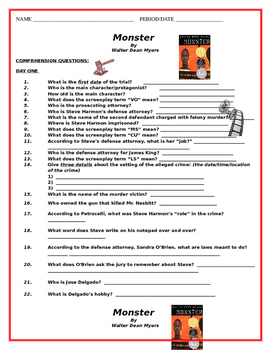

Which witnesses were sympathetic to Steve? Who is credible-the witnesses or Steve?ĩ. They can’t touch my soul.”What does he mean by this? Is he right?Ĩ. What makes the characters so realistic? How do they make the story and life in jail seem real? One of the prisoners, Acie, says, “All they can do is put me in jail. The book’s characters are diverse in many ways, including race, background, and age. It was me who lay on the cot wondering if I was fooling myself.” Why doesSteve begin to doubt himself?ħ.

After a visit from his mother, Steve says, “I knew she felt that I didn’t do anything wrong. Who is right? What happens to truth in our legal system? Are people always encouraged to tell the truth? Are lawyers always most concerned with the truth? Are fact and nonfact the same as truth and nontruth? How might the characters in Monster answer this question?Ħ. Reread the prisoners’ debate on truth (pages 220–222). Steve imagines the defense attorney is looking at him and wondering “who the real Steve Harmon was.” Who is the real Steve Harmon? Is he a “monster,” as the prosecutor calls him? Why is it so important to Steve to have a better understanding of who he is?ĥ. Steve also writes that the story is “told as it actually happened.” Is that true? How does the fact that the story is told from Steve’s point of view influence what the reader knows about the events surrounding the robbery?Ĥ. In the opening credits to his movie, Steve writes that this is “the incredible story of how one guy’s life was turned around by a few events.” When does Steve lose control of his own fate? What could he have done differently to avoid the situation he finds himself in?ģ. Is justice served in Steve’s case? Based on the evidence, what was Steve’s role during the robbery? Should he have been charged with, or convicted of, felony murder? How should the jury have voted?Ģ.


 0 kommentar(er)
0 kommentar(er)
